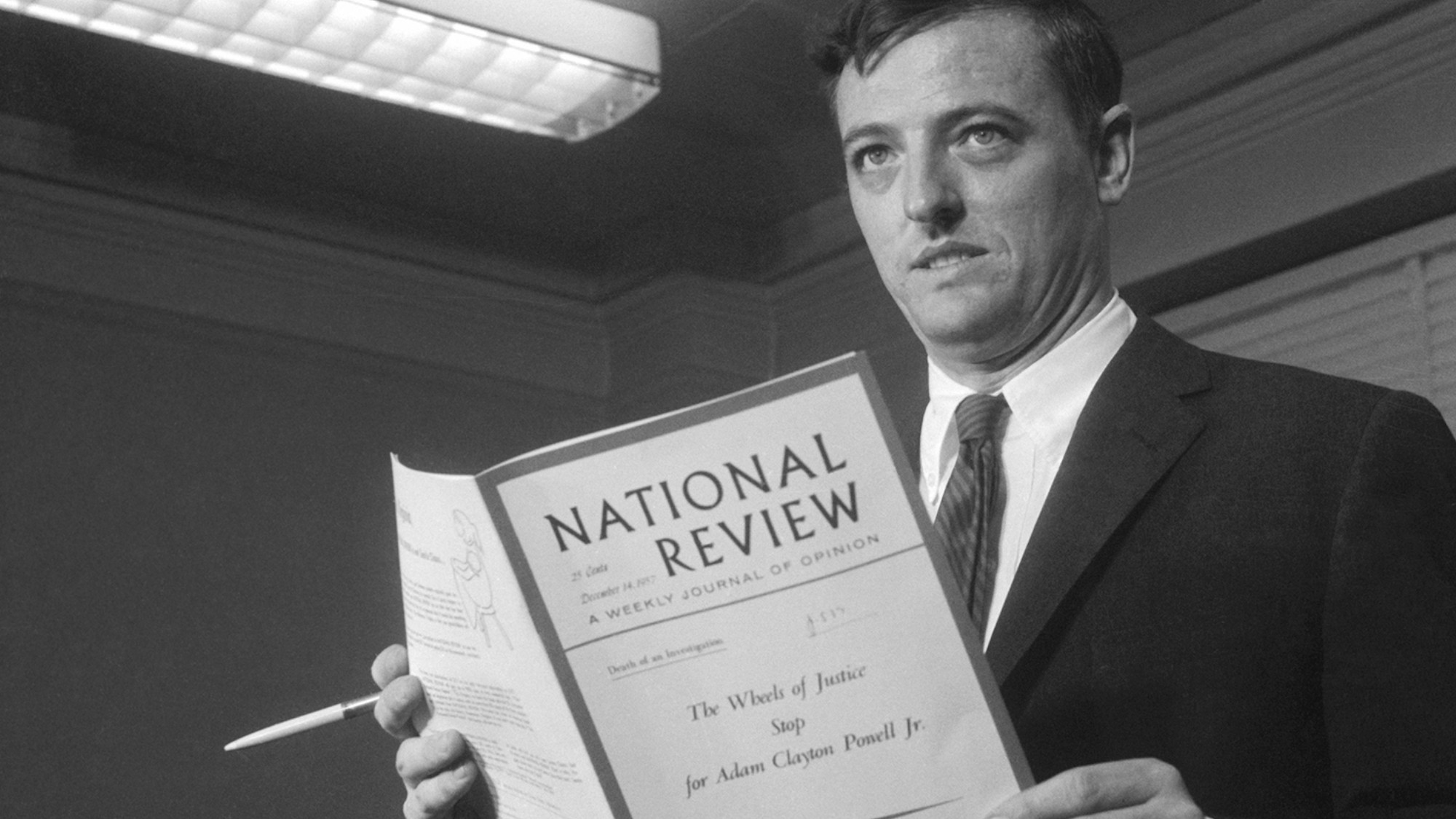Book reviews: 'Buckley: The Life and the Revolution That Changed America' and 'How to Be Well: Navigating Our Self-Care Epidemic, One Dubious Cure at a Time'
How William F. Buckley Jr brought charm to conservatism and a deep dive into the wellness craze

'Buckley: The Life and the Revolution That Changed America' by Sam Tanenhaus
Though William F. Buckley Jr. was often imitated, said Louis Menand in The New Yorker, "at heart he was inimitable." Sam Tanenhaus' long-awaited new biography of this key figure in the rise of postwar American conservatism is "a well-written and intelligent take on a complicated man," and it reminds us that Buckley helped found and sustain the movement while being more an entertainer than a thinker. As a syndicated columnist, the founder of National Review, and the longtime host of PBS's Firing Line, Buckley helped repopularize the moribund Republican Party, and he earned a crowning triumph when his friend Ronald Reagan was elected president in 1980. Even his foes tended to like him, thanks to his personal warmth and charm. Still, given his firm belief in rule by the elite and his opposition to democratic egalitarianism, "it seems fair to say that Buckley was, at bottom, anti-American."
Tanenhaus' "marvelous" 1,000-page book complicates the standard view of Buckley's legacy, said Jack McCordick in The New Republic. While it's common to credit the preppie pundit for having been a responsible leader who purged the conservative movement of its crazies, including the John Birch Society, Tanenhaus refuses to paint Buckley's conservativism as sunnier than today's. Though he provides an affectionate portrait of Buckley as a social figure and describes him as almost liberal in his openness to entertaining conflicting political views, he "also methodically surfaces the darker strains of the movement." Whether Buckley was defending racial segregation, blasting university elites, or stirring up anti-Communist paranoia, the political vision that he helped forge "was, as it is now, concerned not primarily with advancing a particular set of principles but with defining and rooting out perceived enemies."
Tanenhaus is without doubt "a gifted writer," said Barton Swaim in The Wall Street Journal. That's probably why Buckley handpicked him as his biographer in 1997. But Tanenhaus, who later became the editor of The New York Times Book Review, is a left-leaning thinker who has assumed the role of explaining the Right to nonbelievers, and the Buckley he portrays here is "little more than a wasted talent: a man who put his stupendous gifts in the service of a perverse cause" and, in the end, "probably compounded the nation's problems." But he misreads Buckley's views on key issues, including supply side economics and South African apartheid, and his decisions about what to mention and what to exclude "frequently mystify." Unfortunately, Tanenhaus' Buckley turns out to be "more or less the book conservatives feared it would be"— and proof that "Bill Buckley always was too trusting of people he liked."
The Week
Escape your echo chamber. Get the facts behind the news, plus analysis from multiple perspectives.

Sign up for The Week's Free Newsletters
From our morning news briefing to a weekly Good News Newsletter, get the best of The Week delivered directly to your inbox.
From our morning news briefing to a weekly Good News Newsletter, get the best of The Week delivered directly to your inbox.
'How to Be Well: Navigating Our Self-Care Epidemic, One Dubious Cure at a Time' by Amy Larocca
Author Amy Larocca is "far from the only woman who has chased the idea of being not just healthy but well," said Sheila McClear in The Atlantic. But the former New York magazine fashion editor has now also thrown herself into exploring the full depth and breadth of the wellness craze. Larocca "can't deny being a willing participant as well as a skeptic." When she submits to a colonic cleanse and says she hopes it will help her reach a higher plane, "she's being somewhat facetious—but only somewhat." She understands that as the dysfunction of the U.S. health-care system has driven people to seek alternative paths to health and serenity, wellness has grown into not just a $6.6 trillion global business but a new religion with adherents on the both the Right and Left.
How to Be Well reads "like a fun-house mirror held up to my Gen X soul," said Jill Kargman in Air Mail. Besides providing "a fascinating history of wellness," Larocca has also constructed "a searing portrait of over-the-top 'well' women in search of meaning." She has met "the bone-broth sippers, the meditation gurus, and the breath-work believers," and she shows how fitness devotion becomes, for many of them, a tie into a tribe distinguished by fervent faith. Women, she points out, have probably been disproportionately enthusiastic about wellness in part because their health concerns have been neglected by doctors. She's also good at showing how fringe wellness practices creep into the mainstream, and she does it all by mixing "a healthy dose of curiosity" with "a dash of cayenne-pepper cynicism."
Because the book's second half tries to cover so much ground, it "reads like a survey course," said Elisabeth Egan in The New York Times. "But when Larocca goes deep, as she does on self-care, body confidence, and sex positivity, she's at her best— authoritative and witty, personal without being chummy." Though not every wellness product or service is a scam, she's "refreshingly" honest about the motives of most of the companies and influencers pushing them. Their job is to persuade consumers to keep coming back and buying products and services. "That, as How to Be Well wisely shows us, is the bottom line."
A free daily email with the biggest news stories of the day – and the best features from TheWeek.com
-
 The Week’s big New Year’s Day quiz 2026
The Week’s big New Year’s Day quiz 2026Quiz of the Year How much do you remember about 2025’s headlines? Put yourself to the test with our bumper quiz of the year
-
 Is tanking ruining sports?
Is tanking ruining sports?Today's Big Question The NBA and the NFL want teams to compete to win. What happens if they decide not to?
-
 ‘Netflix needs to not just swallow HBO but also emulate it’
‘Netflix needs to not just swallow HBO but also emulate it’instant opinion Opinion, comment and editorials of the day
-
 The best food books of 2025
The best food books of 2025The Week Recommends From mouthwatering recipes to insightful essays, these colourful books will both inspire and entertain
-
 Art that made the news in 2025
Art that made the news in 2025The Explainer From a short-lived Banksy mural to an Egyptian statue dating back three millennia
-
 Nine best TV shows of the year
Nine best TV shows of the yearThe Week Recommends From Adolescence to Amandaland
-
 Winter holidays in the snow and sun
Winter holidays in the snow and sunThe Week Recommends Escape the dark, cold days with the perfect getaway
-
 8 new cookbooks begging to be put to good winter use
8 new cookbooks begging to be put to good winter usethe week recommends Booze-free drinks, the magic versatility of breadcrumbs and Japanese one-pot cooking
-
 The best homes of the year
The best homes of the yearFeature Featuring a former helicopter engine repair workshop in Washington, D.C. and high-rise living in San Francisco
-
 Critics’ choice: The year’s top 10 movies
Critics’ choice: The year’s top 10 moviesFeature ‘One Battle After Another’ and ‘It Was Just an Accident’ stand out
-
 A luxury walking tour in Western Australia
A luxury walking tour in Western AustraliaThe Week Recommends Walk through an ‘ancient forest’ and listen to the ‘gentle hushing’ of the upper canopy